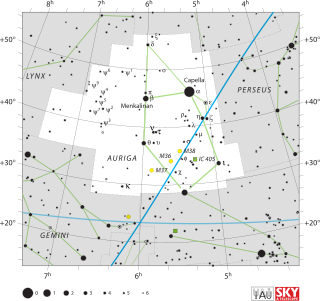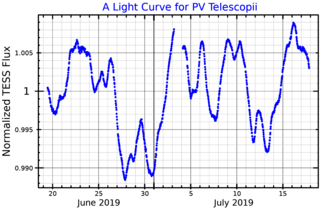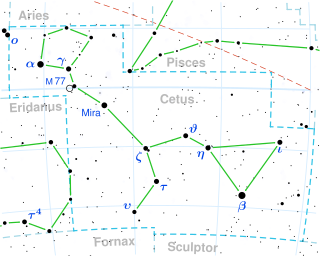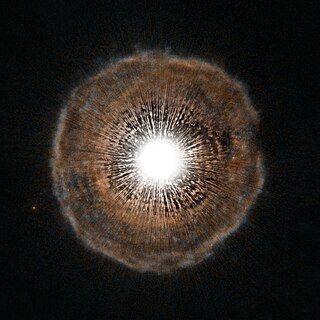
Delta Aurigae, Latinized from δ Aurigae, is the Bayer designation for an astrometric binary star in the northern constellation of Auriga. It is visible to the naked eye with an apparent visual magnitude of 3.715. Based upon its annual parallax shift of 23.06 mas, it is some 141 light-years distant from the Earth, give or take a three light-year margin of error. It is drifting further away with a radial velocity of +10 km/s. This star is the namesake for the Delta Aurigids, a meteor shower that occurs between October 6–15. The radiant point for this shower passes several degrees to the south of the star.
Kappa Leonis, Latinized from κ Leonis, is a double star in the constellation Leo. It was called Al-minħar al-asad, meaning the Lion's nose. The name is corrupted as Al Minliar al Asad in the Yale Bright Star Catalogue. This star is visible to the naked eye with an apparent visual magnitude of 4.46. It has an annual parallax shift of 16.20 mas as seen from Earth, which provides a distance estimate of about 201 light years. Kappa Leonis is moving away from the Sun with a radial velocity of +28 km/s.

53 Camelopardalis is a binary star system in the northern circumpolar constellation of Camelopardalis, located 290 light years away from the Sun as determined by parallax measurements. It has the variable star designation AX Camelopardalis; 53 Camelopardalis is the Flamsteed designation. This object is dimly visible to the naked eye as a white hued star with a baseline apparent visual magnitude of +6.02. It is a single-lined spectroscopic binary system with an orbital period of 6.63 years and a high eccentricity of 0.718. The "a sin i" value of the primary is 280 Gm (1.9 AU), where a is the semimajor axis and i is the orbital inclination.

Omicron Cassiopeiae is a triple star system in the constellation Cassiopeia. It is approximately 700 light-years from Earth, based on its parallax. It is visible to the naked eye with a slightly variable apparent magnitude of about 4.5.
HD 115310, also known by its Bayer designation r Centauri, is a star in the southern constellation Centaurus. It is an orange-hued star that is visible to the naked eye with an apparent visual magnitude that ranges around +5.12. Based upon parallax measurements, it is located approximately 257 light years away. It is drifting further from the Sun with a radial velocity of +12.9 km/s.

Zeta Cephei is a star in the constellation of Cepheus. Zeta Cephei marks the left shoulder of Cepheus, the King of Joppa (Ethiopia). It is one of the fundamental stars of the MK spectral sequence, defined as type K1.5 Ib.

31 Vulpeculae is a binary star system in the northern constellation of Vulpecula. It is visible to the naked eye as a faint, yellow-hued point of light with an apparent visual magnitude of 4.56. The system is located approximately 228 light years away from the Sun based on parallax, and it is drifting further away with a radial velocity of +2.25 km/s.

HR Carinae is a luminous blue variable star located in the constellation Carina. It is surrounded by a vast nebula of ejected nuclear-processed material because this star has a multiple shell expanding atmosphere. This star is among the most luminous stars in the Milky Way. It has very broad emission wings on the Balmer lines, reminiscent from the broad lines observed in the spectra of O and Wolf–Rayet stars. A distance of 5 kpc and a bolometric magnitude of -9.4 put HR Car among the most luminous stars of the galaxy.

Beta Leonis Minoris, Latinized from β Leonis Minoris, is a binary star in the constellation of Leo Minor. It has an overall apparent visual magnitude of approximately 4.2. Although it is the only star in Leo Minor with a Bayer designation, it is only the second brightest star in the constellation.

3 Camelopardalis is a spectroscopic and visual binary in the constellation Camelopardalis. It is approximately 496 light years from Earth.

PV Telescopii variable is a type of variable star that is established in the General Catalogue of Variable Stars with the acronym PVTEL. This class of variables are defined as "helium supergiant Bp stars with weak hydrogen lines and enhanced lines of He and C". That is, the hydrogen spectral lines of these stars are weaker than normal for a star of stellar class B, while the lines of helium and carbon are stronger. They are a type of extreme helium star.

V381 Cephei is a triple star system in the northern constellation of Cepheus. Its apparent magnitude is slightly variable between 5.5 and 5.7.

ν Ceti, Latinized as Nu Ceti, is a binary star system in the equatorial constellation of Cetus. It is visible to the naked eye as a faint point of light with a combined apparent visual magnitude of 4.86. The system is located approximately 340 light years distant from the Sun, based on parallax, and is drifting further away with a radial velocity of 4.8 km/s. Nu Ceti is believed to be part of the Ursa Major stream of co-moving stars.

HD 106112, also known as CO Camelopardalis, is a star in the constellation Camelopardalis. It has an apparent magnitude of about 5.1, meaning that it is just barely visible to the naked eye. Based upon parallax measurements made by the Hipparcos spacecraft, this star is around 177 light years away from the Sun.

U Camelopardalis is a semiregular variable star in the constellation Camelopardalis. Based on parallax measurements made by the Hipparcos spacecraft, it is located about 3,000 light-years away from the Earth. Its apparent visual magnitude is about 8, which is dim enough that it cannot be seen with the unaided eye.

Gamma Phoenicis is a star system in the constellation Phoenix, located around 71.63 parsecs (233.6 ly) distant.

QZ Puppis is a class B2.5V star in the constellation Puppis. Its apparent magnitude is 4.5 and it is approximately 650 light years away based on parallax.

31 Cygni, also known as ο1 Cygni, Omicron1 Cygni, or V695 Cygni, is a triple star system about 750 light years away in the constellation Cygnus.

HR 6819, also known as HD 167128 or QV Telescopii, is a double star system in the southern constellation of Telescopium. It is in the south-western corner of the constellation, near Pavo to the south and Ara to the west. The system appears as a variable star that is dimly visible to the naked eye with an apparent magnitude that ranges from 5.32 down to 5.39, which is comparable to the maximum brightness of the planet Uranus. It is about 1,120 light years from the Sun, and is drifting farther away at a rate of 9.4 km/s. Due to its location in the sky, it is visible only to observers south of 33°N latitude.

CH Cygni is a red giant, variable, symbiotic binary in the constellation Cygnus. It is the nearest symbiotic star to Earth, and one of the brightest, making it an ideal candidate for study.
















